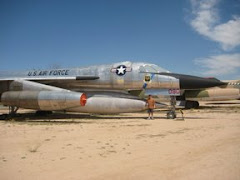Simpson went to the end of the runway, received clearance and gunned the throttles. He left the ground at 11:35am, local time. After leaving field, he climbed east to 32,000 feet. He leveled out and spent ten minutes making turns. At this time, he decided to roll the plane over and dive straight down. He looked at his air speed, it “was about 300 MPH.” He tried to take it out of the dive, but he had no control. He tried several different methods, from trim tabs to gunning the engine. Nothing worked. As the ground rushed toward him, he realized he needed to exit the aircraft. He released the canopy and put his head and shoulders into the slipstream. The onrushing air pulled him out, but he was knocked unconscious.
He came to as he fell to the ground. He could not move his hand to pull his ripcord, but the wind action had pulled his chute partially open, and then it fully opened, though some of the shrouds were broken. He floated down and hit the sage brush hard. He hit the ground at about 12:30pm. After about an hour and-a-half he found a road then a ranger who took the downed pilot to his cabin and fed him soup and coffee until the ambulance picked him up.
Once he left P-38H #42-66778, Simpson floated to the ground for a comparatively gentle landing, living to fly another day. However, 66778 did not meet a similar fate. It rocketed toward the ground. Some have suggested it broke up in flight, which would be supported by the evidence on the ground today. This aircraft’s wreckage is strewn from near the summit of the hill, down to about 400-500 feet below the summit. Some of the largest pieces were toward the bottom. There appeared to be no impact crater.
Given the P-38’s tendency to be a fast machine, it was one of the first aircraft that introduced aero-engineers and pilots to the phenomenon of compressability. When the airframe reached speeds near 500 miles per hour, the nose would tuck under and the pilot would loose control. From Simpson’s testimony, this is what apparently happened to 66778, though 300 MPH seems a bit low for that to happen. Due to the aerodynamic forces in play and the P-38’s high lift wing, it seems entirely possible that the airplane broke up in flight.
Craig Gyselinck discovered #42-66778’s crash site in 2003. He described it as being scattered over one square mile. He also described finding live ammunition. He was a high school student at the time. There was an article on this in the Ellensburg Daily Record, which you can find here.
On October 16, 2010, I accompanied Mr. Gene Gould to the site of #42-66778. We found bright aluminum and even a little stainless steel shining in the sun across a gully from us. In the course of investigating the debris we found several items of interest. Among them, part of one of the turbo-superchargers, and a head and valve cover from one of the Allisons. The photos below will tell a more complete story of our visit.

It doesn’t look at steep as it felt…trust me, my aching muscles are telling me it was nearly a vertical hill!



Above is the cylinder housing from the engine. Below is the exhaust manifold.




One of the prefixes for P-38 parts is 19, this confirms it.



Above is some sort of flapper allowing air flow, one suspects cooling air for one of the engines, but I don’t know for sure. Below is one of the turbo-superchargers. The patterns seem to indicate it was still turning when it hit.



Part numbers.












Above is part of a radio.


This head from an Allison V-1710 shows the difference between engines in cars and those meant for flight.





We found pieces with this desert pink and OTHERS with olive drab.






Below are a few shells. The primers were not fired, so one COULD say this was live ammunition.




As with my first wreck, I am amazed by the small size and great scattering of the pieces of this aircraft. That the larger items we found we toward the bottom of the hill would suggest that there may be more there. We got to a point where we were thirsty and well below our back packs, so we headed back up slope. It was well worth the effort. It was a very interesting crash site!
sources:
USAF accident report for #42-66778
Ellensburg Daily Record, December 27, 2003, http://news.google.com/newspapers?id=pWYpAAAAIBAJ&sjid=l8cEAAAAIBAJ&dq=ellensburg%20fighter%20crash&pg=3443%2C7373466







1 comment:
Hello Awesome Jim,
I located this site using your photos and some of the info provided. I should like to share the story/pics with you by and by.
Post a Comment